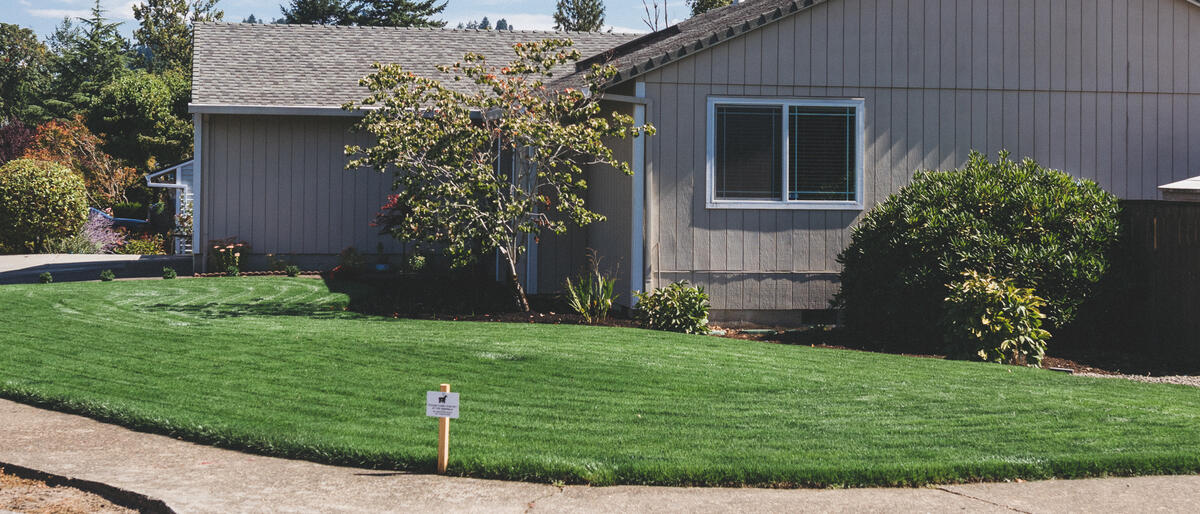Seeding a lawn from scratch in Portland Oregon? Follow these 8 Simple steps!


When you think of spring and summer you likely envision being outside on your lawn, watching children play and dogs run. Did the winter take over your lawn or did the heat of summer deplete it’s luster? Seeding a new lawn is a great way of getting your lawn back to lush green beauty or “green gold” as we like to call it. Spring or fall are both excellent times to start a new lawn from scratch. Read below for detailed supply lists and simple step-by-step instructions on how to seed your lawn while taking into account the conditions specific to Portland Oregon.
Your first step is to test your pH. You want to do this first as it will determine the soil amendments you purchase. You can buy a tester at any home store and simply follow the label instructions. Soil pH is considered balanced if it is between a 6.0 and 7.5. In Oregon, most soils will test below 6.0, making the soil acidic. In this case adding lime will make the soil pH more alkaline. If you get a pH result above 7.5, your soil is too alkaline. Use peat moss for readings between 7.5 and 8.0, and sulfur for readings above 8.0.
Once you get your sod cutter unloaded and on your existing lawn to be removed, set the depth to 1-2". Use a tactic similar to mowing your grass, by overlapping each row by 1". This prevents missing any areas that would require going over it twice (who wants more work). Roll up the grass for disposal.*Expert Tip* Tilling in grass or organic material, rather than complete removal, will result in divots through out lawn as result of decomposition over time.
Before tilling, dig up large rocks (bigger than what can be raked) and roots. Next, fill in any holes bigger then 1". After that is completed you are now ready to till the area which is to be seeded. Turn the soil to remove all earth compaction and large clumps, down to an approximate 3-6" depth.
Use a wheelbarrow to transport the soil to the site and shovel the soil evenly with sterilized (prevents weed seed from spouting in your new lawn) 3-way soil. 3-way soil is an even mixture of sand, compost and soil. The sand provides drainage and the compost/sand provide nutrients. Use your tiller to incorporate the 3-way soil. You will want to finish by hand raking (use grading rake) to ensure grading is correct for proper drainage (this can be tricky, contact a professional with any questions).
Depending on the results of you pH test, you will amend your soil with lime, peat moss or sulfur. Likely, you will need to amend your soil with lime, as Portland, Oregon's (and usually the entire Pacific Northwest), soil is too acidic. If you are using lime or sulfur, use a walk behind spreader and set distribution to the appropriate rate. If you are using peat moss, use your hands to distribute evenly. Make sure you cover the area completely, while being careful not to miss any areas. Next, apply slow release starter fertilizer to the area, at approximately 7 pounds per 1,000 square feet. All amendments should be evenly distributed with no large clumps. This is especially important for the fertilizer, as clumps can burn new grass.Lightly rake (plastic rake) in the amendments. Now you are ready to use a weighted roller. Roll the area until it is nice and smooth.
Grass seed should be chosen based on your landscape's lighting conditions. If your lawn is shady, use a seed specific to shade. If your lawn is in full sun, use a seed specific to full sun use. If you have a combination of both conditions, we recommend using equal parts of shade and sun seed varieties by mixing them in the spreader. Use a walk behind spreader for large areas and a hand spreader for small areas.Sow half your seed in one direction and the other in the opposite direction, doing so ensures complete coverage. Rake the seed lightly into the soil and use your weighted roller again.
Lightly cover the newly seeded area with peat moss at an approximate 1/2" depth. Do not apply mulch too thick, as light needs to penetrate the cover. Grass seed needs to be kept wet like a sponge, not sopping (this will rot the seed) or too dry (the seed will not grow). For the first 10 days of germination, water 5 - 10 minutes, 2-3 times per day. Once sprouting occurs, increase watering time to 15-30 minutes, once a day. Avoid flooding any areas, as over-watering will cause the seed to wash away.*Expert Tip* Peat moss as mulch does not affect the pH of your soil in this application. Typically, it will decompose off the surface preventing absorption.
Once your beautiful, luscious lawn is about 2-3 inches, regular mowing may began. Weekly mowing during the growing season will ensure optimal greenery and health. Re-seed any areas that look thin. Keep broad-leaf weeds and crabgrass at bay with a pre-emergent weed control. Keep in mind that pre-emergent also prevent's grass seed from sprouting for up to 6 months, so all seeding needs to completed prior to application. Fertilization should be done approximately every 6-8 weeks depending on the overall greenness of your lawn. Do not fertilize too close to winter; your last fertilization should occur no later than November.*Expert Tip* Establish grass for a minimum of 6 weeks prior to any pre-emergent application, as it may burn tender new grass.Feel free to give us a call if you have questions at 503-669-0606